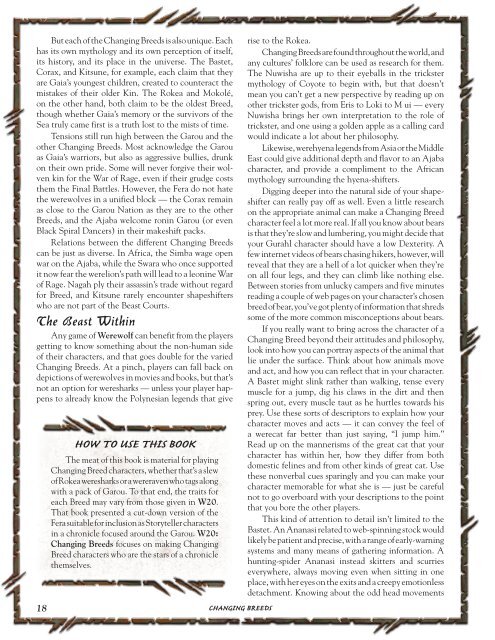Create successful ePaper yourself
Turn your PDF publications into a flip-book with our unique Google optimized e-Paper software.
But each of the <strong>Changing</strong> <strong>Breeds</strong> is also unique. Eachhas its own mythology and its own perception of itself,its history, and its place in the universe. The Bastet,Corax, and Kitsune, for example, each claim that theyare Gaia’s youngest children, created to counteract themistakes of their older Kin. The Rokea and Mokolé,on the other hand, both claim to be the oldest Breed,though whether Gaia’s memory or the survivors of theSea truly came first is a truth lost to the mists of time.Tensions still run high between the Garou and theother <strong>Changing</strong> <strong>Breeds</strong>. Most acknowledge the Garouas Gaia’s warriors, but also as aggressive bullies, drunkon their own pride. Some will never forgive their wolvenkin for the War of Rage, even if their grudge coststhem the Final Battles. However, the Fera do not hatethe werewolves in a unified block — the Corax remainas close to the Garou Nation as they are to the other<strong>Breeds</strong>, and the Ajaba welcome ronin Garou (or evenBlack Spiral Dancers) in their makeshift packs.Relations between the different <strong>Changing</strong> <strong>Breeds</strong>can be just as diverse. In Africa, the Simba wage openwar on the Ajaba, while the Swara who once supportedit now fear the werelion’s path will lead to a leonine Warof Rage. Nagah ply their assassin’s trade without regardfor Breed, and Kitsune rarely encounter shapeshifterswho are not part of the Beast Courts.The Beast WithinAny game of Werewolf can benefit from the playersgetting to know something about the non-human sideof their characters, and that goes double for the varied<strong>Changing</strong> <strong>Breeds</strong>. At a pinch, players can fall back ondepictions of werewolves in movies and books, but that’snot an option for weresharks — unless your player happensto already know the Polynesian legends that give18HOW TO USE THIS BOOKThe meat of this book is material for playing<strong>Changing</strong> Breed characters, whether that’s a slewof Rokea weresharks or a wereraven who tags alongwith a pack of Garou. To that end, the traits foreach Breed may vary from those given in <strong>W20</strong>.That book presented a cut-down version of theFera suitable for inclusion as Storyteller charactersin a chronicle focused around the Garou. <strong>W20</strong>:<strong>Changing</strong> <strong>Breeds</strong> focuses on making <strong>Changing</strong>Breed characters who are the stars of a chroniclethemselves.CHANGING BREEDSrise to the Rokea.<strong>Changing</strong> <strong>Breeds</strong> are found throughout the world, andany cultures’ folklore can be used as research for them.The Nuwisha are up to their eyeballs in the trickstermythology of Coyote to begin with, but that doesn’tmean you can’t get a new perspective by reading up onother trickster gods, from Eris to Loki to Māui — everyNuwisha brings her own interpretation to the role oftrickster, and one using a golden apple as a calling cardwould indicate a lot about her philosophy.Likewise, werehyena legends from Asia or the MiddleEast could give additional depth and flavor to an Ajabacharacter, and provide a compliment to the Africanmythology surrounding the hyena-shifters.Digging deeper into the natural side of your shapeshiftercan really pay off as well. Even a little researchon the appropriate animal can make a <strong>Changing</strong> Breedcharacter feel a lot more real. If all you know about bearsis that they’re slow and lumbering, you might decide thatyour Gurahl character should have a low Dexterity. Afew internet videos of bears chasing hikers, however, willreveal that they are a hell of a lot quicker when they’reon all four legs, and they can climb like nothing else.Between stories from unlucky campers and five minutesreading a couple of web pages on your character’s chosenbreed of bear, you’ve got plenty of information that shredssome of the more common misconceptions about bears.If you really want to bring across the character of a<strong>Changing</strong> Breed beyond their attitudes and philosophy,look into how you can portray aspects of the animal thatlie under the surface. Think about how animals moveand act, and how you can reflect that in your character.A Bastet might slink rather than walking, tense everymuscle for a jump, dig his claws in the dirt and thenspring out, every muscle taut as he hurtles towards hisprey. Use these sorts of descriptors to explain how yourcharacter moves and acts — it can convey the feel ofa werecat far better than just saying, “I jump him.”Read up on the mannerisms of the great cat that yourcharacter has within her, how they differ from bothdomestic felines and from other kinds of great cat. Usethese nonverbal cues sparingly and you can make yourcharacter memorable for what she is — just be carefulnot to go overboard with your descriptions to the pointthat you bore the other players.This kind of attention to detail isn’t limited to theBastet. An Ananasi related to web-spinning stock wouldlikely be patient and precise, with a range of early-warningsystems and many means of gathering information. Ahunting-spider Ananasi instead skitters and scurrieseverywhere, always moving even when sitting in oneplace, with her eyes on the exits and a creepy emotionlessdetachment. Knowing about the odd head movements




![Changeling - Beyond Arcadia [Unofficial].pdf](https://img.yumpu.com/52285811/1/184x260/changeling-beyond-arcadia-unofficialpdf.jpg?quality=85)